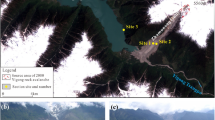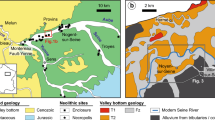Abstract
CATASTROPHIC flooding occurred in the Lower Thames and lowland coastal areas of eastern England in 1953. Large-scale investment in port, freight, factory facilities and connected urban development, has centred in these littoral and coastal zones. The effects of changing sealevels, such as seen in 1953, could, therefore, cause even greater economic and human loss in the future, unless government expenditure on flood alleviation schemes, as exemplified by the Thames barrage project, is increased and a coordinated flood protection policy established. Information on the rate of changing relative sealevel in south-east England is thus of great value. (A description is given here of a stratigraphic study upon the interleaved Flandrian biogenic and inorganic deposits of the Lower Thames estuary, carried out between central London and the Isle of Grain (Fig. 1).) From this, the heights of relative sealevel movements were determined and plotted against time to show the rate of relative sealevel change and subsidence trends for the Thames and southern England. The vegetational and environmental history was deduced from pollen, diatom and other micro-fossil analyses, with radiocarbon dating applied to establish an objective chronology.
This is a preview of subscription content, access via your institution
Access options
Subscribe to this journal
Receive 51 print issues and online access
$199.00 per year
only $3.90 per issue
Buy this article
- Purchase on Springer Link
- Instant access to full article PDF
Prices may be subject to local taxes which are calculated during checkout
Similar content being viewed by others
References
Smith, A. G. & Pilcher, J. R. New Phytol. 72, 903–914 (1973).
Godwin, H. The History of the British Flora. (Cambridge University Press, Cambridge, 1975).
Skempton, A. W. Q. Jl geol. Soc. Lond. 125, 373–412 (1970).
Marsland, A. Q. J. Engng Geol. 10, 1–26 (1977).
Jelgersma, S. Meded. Geol. Sticht. Ser. C 6, 1–100 (1961).
Tooley, M. J. Geol. J. 11, 137–152 (1976).
Morner, N-A. Palaeogeogr. Palaeoclimatol. Palaesecol. 19, 63–85 (1976).
Greensmith, J. T. & Tucker, E. V. Geol. en Mijnb. 52, 193–202 (1973).
Tooley, M. J. Geogr. J. 140, 18–42 (1974).
Morner, N-A. J. Geol. 84, 123–151 (1976).
Dunham, K. C. Phil. Trans. R. Soc. Lond. A 272, 81–86 (1972).
Churchill, D. M. Quaternaria 7, 239–249 (1965); Proc. prehist. Soc. 5, 74–84 (1965).
Bowen, A. J. Phil. Trans. R. Soc. Lond. A 272, 187–199 (1972).
Rossiter, J. R. Geophys. J. R. astr. Soc. 12, 259–299 (1967).
Gaunt, G. D. & Tooley, M. J. Bull. Inst. geol. Sci. 48, 25–41 (1974).
Devoy, R. J. thesis, Univ. Cambridge.
Author information
Authors and Affiliations
Rights and permissions
About this article
Cite this article
DEVOY, R. Flandrian sealevel changes in the Thames Estuary and the implications for land subsidence in England and Wales. Nature 270, 712–715 (1977). https://doi.org/10.1038/270712a0
Received:
Accepted:
Published:
Issue Date:
DOI: https://doi.org/10.1038/270712a0
This article is cited by
-
Holocene eustatic sea level change
Nature (1978)
Comments
By submitting a comment you agree to abide by our Terms and Community Guidelines. If you find something abusive or that does not comply with our terms or guidelines please flag it as inappropriate.



